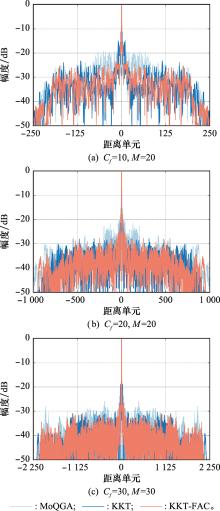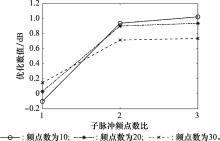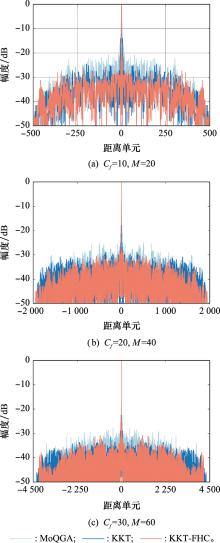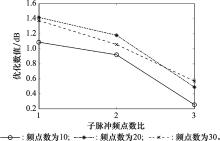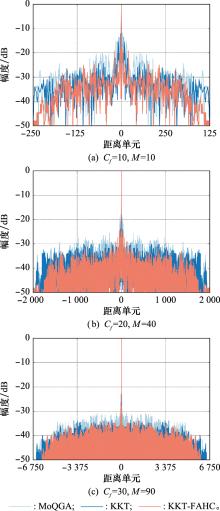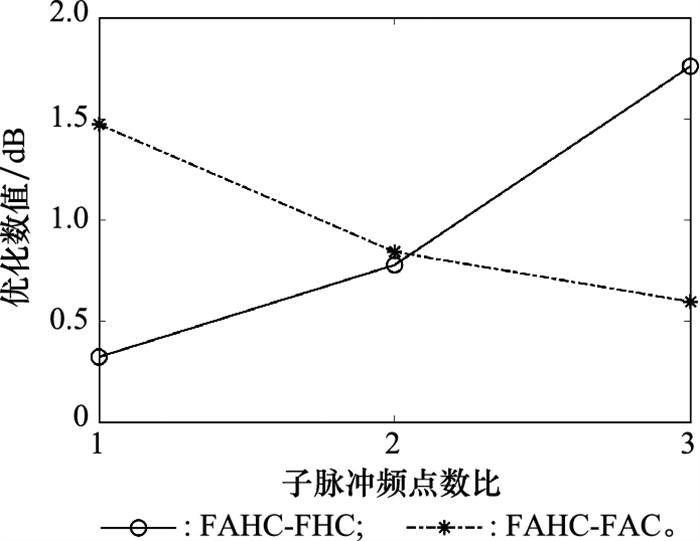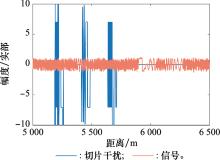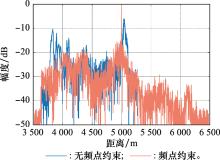Systems Engineering and Electronics ›› 2025, Vol. 47 ›› Issue (5): 1495-1506.doi: 10.12305/j.issn.1001-506X.2025.05.12
• Sensors and Signal Processing • Previous Articles
Frequency-controllable FSK-PSK waveform design algorithm based on KKT optimality conditions
Shurong LYU1, Siqi LIU1, Huili SHI2, Jindong ZHANG1,*
- 1. College of Electronic and Information Engineering, Nanjing University of Aeronautics and Astronautics, Nanjing 211016, China
2. Leihua Electronic Technology Research Institute, Aviation Industry Corporation of China, Wuxi 214063, China
-
Received:2023-10-09Online:2025-06-11Published:2025-06-18 -
Contact:Jindong ZHANG
CLC Number:
Cite this article
Shurong LYU, Siqi LIU, Huili SHI, Jindong ZHANG. Frequency-controllable FSK-PSK waveform design algorithm based on KKT optimality conditions[J]. Systems Engineering and Electronics, 2025, 47(5): 1495-1506.
share this article
Table 1
Performance comparison of MoQGA, KKT and KKT-FAC algorithms dB"
| 参数/优化算法 | MoQGA | KKT | KKT-FAC |
| cf=10, M=10 | -30.224 8 | -33.661 2 | -33.558 3 |
| cf=10, M=20 | -32.131 6 | -35.454 8 | -36.392 6 |
| cf=10, M=30 | -33.497 6 | -36.611 0 | -37.633 9 |
| cf=20, M=20 | -35.307 5 | -38.459 6 | -38.489 4 |
| cf=20, M=40 | -38.575 8 | -40.554 0 | -41.456 0 |
| cf=20, M=60 | -39.406 1 | -42.089 9 | -43.027 0 |
| cf=30, M=30 | -39.622 1 | -41.593 3 | -41.738 4 |
| cf=30, M=60 | -41.614 5 | -43.827 9 | -44.542 2 |
| cf=30, M=90 | -43.242 1 | -45.281 3 | -46.016 3 |
Table 2
Performance comparison of MoQGA, KKT and KKT-FHC algorithms dB"
| 参数/优化算法 | MoQGA | KKT | KKT-FHC |
| cf=10, M=10 | -30.384 0 | -33.623 2 | -34.711 3 |
| cf=10, M=20 | -31.824 1 | -35.536 7 | -36.457 2 |
| cf=10, M=30 | -33.250 3 | -36.209 5 | -36.466 4 |
| cf=20, M=20 | -35.923 4 | -37.809 5 | -39.228 1 |
| cf=20, M=40 | -38.249 1 | -40.823 7 | -41.603 5 |
| cf=20, M=60 | -39.738 0 | -42.641 6 | -43.132 6 |
| cf=30, M=30 | -39.635 5 | -41.744 4 | -43.120 0 |
| cf=30, M=60 | -41.774 7 | -44.189 2 | -45.246 2 |
| cf=30, M=90 | -43.119 0 | -45.447 6 | -46.018 5 |
Table 3
Performance comparison of MoQGA, KKT and KKT-FAHC algorithms dB"
| 参数/优化算法 | MoQGA | KKT | KKT-FAHC |
| cf=10, M=10 | -30.530 1 | -33.676 5 | -35.032 9 |
| cf=10, M=20 | -31.787 5 | -35.559 6 | -37.235 1 |
| cf=10, M=30 | -33.650 5 | -36.700 6 | -38.229 5 |
| cf=20, M=20 | -35.647 9 | -37.650 2 | -39.751 3 |
| cf=20, M=40 | -37.855 0 | -40.619 7 | -42.607 0 |
| cf=20, M=60 | -39.356 6 | -42.252 3 | -43.735 4 |
| cf=30, M=30 | -39.060 3 | -42.002 4 | -44.264 5 |
| cf=30, M=60 | -41.835 6 | -44.063 8 | -45.938 0 |
| cf=30, M=90 | -43.250 2 | -45.194 2 | -46.433 9 |
| 1 |
FEI Z T , ZHAO J C , GENG Z , et al. Hybrid FSK-PSK waveform optimization for radar based on alternating direction method of multiplier (ADMM)[J]. Sensors, 2021, 21 (23): 7915.
doi: 10.3390/s21237915 |
| 2 | EEDARA I P, AMIN M G, HASSANIEN A. Analysis of communication symbol embedding in FH MIMO radar platforms[C]//Proc. of the IEEE Radar Conference, 2019. |
| 3 | CEN X , LI Y C , HAN Z Y , et al. Self-supervised learning method for SAR multiinterference suppression[J]. IEEE Trans. on Geoscience and Remote Sensing, 2023, 61, 5220017. |
| 4 | SHIMURA T, UMEHIRA M, WATANABE Y, et al. An advanced wideband interference suppression technique using envelope detection and sorting for automotive FMCW radar[C]//Proc. of the IEEE Radar Conference, 2022. |
| 5 |
LIU T Q , SUN J P , WANG G H , et al. Designing low side-lobe level-phase coded waveforms for MIMO radar using P-norm optimization[J]. IEEE Trans. on Aerospace and Electronic Systems, 2023, 59 (4): 3797- 3810.
doi: 10.1109/TAES.2022.3232310 |
| 6 |
JIANG P K , GONG P C , WU Y T , et al. Multiple-input multiple-output with frequency diverse array radar transmit beamforming design for low-probability-of-intercept in cluttered environments[J]. IET Signal Processing, 2022, 16 (7): 811- 820.
doi: 10.1049/sil2.12112 |
| 7 |
CHEN K J , XIE C M , YANG F , et al. Integrated radar and communication design with low probability of intercept based on 4-D antenna arrays[J]. IEEE Trans. on Antennas and Propagation, 2022, 70 (9): 8496- 8506.
doi: 10.1109/TAP.2022.3177508 |
| 8 |
XI R Y , MA D Y , LIU X , et al. Intra-pulse frequency coding design for a high-resolution radar against smart noise jamming[J]. Remote Sensing, 2022, 14 (20): 5149.
doi: 10.3390/rs14205149 |
| 9 |
LONG X W , LI K , TIAN J , et al. Ambiguity function analysis of random frequency and PRI agile signals[J]. IEEE Trans. on Aerospace and Electronic Systems, 2021, 57 (1): 382- 396.
doi: 10.1109/TAES.2020.3016851 |
| 10 |
LI W L , XIANG Z , REN P . Waveform design for dual-function radar-communication system with golay block coding[J]. IEEE Access, 2019, 7, 184053- 184062.
doi: 10.1109/ACCESS.2019.2960658 |
| 11 |
LI K , JIU B , LIU H W , et al. Robust antijamming strategy design for frequency-agile radar against main lobe jamming[J]. Remote Sensing, 2021, 13 (15): 3043.
doi: 10.3390/rs13153043 |
| 12 | AN P F, SHANG Z G, YAN S, et al. Design method of frequency-agile radar frequency hopping sequence based on CNN network and chaotic sequence[C]//Proc. of the International Conference on Big Data, Information and Computer Network, 2022: 702-707. |
| 13 | DONG Y H . Implementable phase-coded radar waveforms featuring extra-low range sidelobes and Doppler resilience[J]. IET Radar, Sonar & Navigation, 2019, 13 (9): 1530- 1539. |
| 14 | DE-JESUS N S, MARCIANO J S. Doppler tolerant modified P4 code (DTMP4 code) for pulse compression radar[C]//Proc. of the IEEE International Symposium on Signal Processing and Information Technology, 2017: 56-61. |
| 15 |
STOICA P , HE H , LI J . New algorithms for designing unimodular sequences with good correlation properties[J]. IEEE Trans. on Signal Processing, 2009, 57 (4): 1415- 1425.
doi: 10.1109/TSP.2009.2012562 |
| 16 |
HE H , STOICA P , LI J . Designing unimodular sequence sets with good correlations—including an application to MIMO radar[J]. IEEE Trans. on Signal Processing, 2009, 57 (11): 4391- 4405.
doi: 10.1109/TSP.2009.2025108 |
| 17 |
AUBRY A , DE-MAIO A , JIANG B , et al. Ambiguity function shaping for cognitive radar via complex quartic optimization[J]. IEEE Trans. on Signal Processing, 2013, 61 (22): 5603- 5619.
doi: 10.1109/TSP.2013.2273885 |
| 18 | LI Y Z, VOROBYOV S A, HE Z S. Design of multiple unimodular waveforms with low auto-and cross-correlations for radar via majorization-minimization[C]//Proc. of the 24th European Signal Processing Conference, 2016: 2235-2239. |
| 19 |
ZHAO L C , SONG J X , BABU P , et al. A unified framework for low autocorrelation sequence design via majorization-mini-mization[J]. IEEE Trans. on Signal Processing, 2017, 65 (2): 438- 453.
doi: 10.1109/TSP.2016.2620113 |
| 20 |
TANG L , ZHU Y F , FU Q . Designing waveform sets with good correlation and stopband properties for MIMO radar via the gradient-based method[J]. Sensors, 2017, 17 (5): 999.
doi: 10.3390/s17050999 |
| 21 |
ALAEE K M , AUBRY A , DE-MAIO A , et al. A coordinate-descent framework to design low PSL/ISL sequences[J]. IEEE Trans. on Signal Processing, 2017, 65 (22): 5942- 5956.
doi: 10.1109/TSP.2017.2723354 |
| 22 |
YU G Y , LIANG J L , LI J , et al. Sequence set design with accurately controlled correlation properties[J]. IEEE Trans. on Aerospace and Electronic Systems, 2018, 54 (6): 3032- 3046.
doi: 10.1109/TAES.2018.2836778 |
| 23 |
LIU T Q , SUN J P , WANG G H , et al. A multi-objective quantum genetic algorithm for MIMO radar waveform design[J]. Remote Sensing, 2022, 14 (10): 2387.
doi: 10.3390/rs14102387 |
| 24 | ROY A, DEB D, NEMADE H B, et al. Design of discrete frequency-coding waveforms using phase-coded linear chirp for multiuser and MIMO radar systems[C]//Proc. of the National Conference on Communications, 2019. |
| 25 |
SUN Y H , FAN H Y , WANG J D , et al. Optimization of diverse PCFM waveforms and joint mismatched filters[J]. IEEE Trans. on Aerospace and Electronic Systems, 2021, 57 (3): 1840- 1854.
doi: 10.1109/TAES.2021.3053105 |
| 26 | EEDARA I P, AMIN M G, HOORFAR A. Optimum code design using genetic algorithm in frequency hopping dual function MIMO radar communication systems[C]//Proc. of the IEEE Radar Conference, 2020. |
| 27 |
CHENG Y A , ZHANG J D , LI C , et al. Orthogonal anti-jamming waveform design with extended Doppler tolerance based on the LFM-PC signal[J]. Digital Signal Processing, 2022, 122, 103334.
doi: 10.1016/j.dsp.2021.103334 |
| 28 | DONOHOE J P, INGELS F M. The ambiguity properties of FSK/PSK signals[C]//Proc. of the IEEE International Confe-rence on Radar, 1990: 268-273. |
| 29 | 郭贵虎, 文贻军, 戴天. 一种新型低截获FSK/PSK雷达信号分析[J]. 电讯技术, 2009, 49 (8): 49- 53. |
| GUO G H , WEN Y J , DAI T . Analysis of a new FSK/PSK radar signal with low probability of interception[J]. Telecommunication Technology, 2009, 49 (8): 49- 53. | |
| 30 | CAO S Q, ZHENG K, MENG X D, et al. Detection perfor-mance analysis on a new multi-cycle FSK/PSK signal[C]//Proc. of the International Conference on Computational Problem-Solving, 2012: 55-58. |
| 31 | 丁逊, 张劲东, 李晨, 等. 基于交替方向乘子法的频率-码型联合捷变波形优化设计[J]. 现代雷达, 2021, 43 (3): 85- 93. |
| DING X , ZHANG J D , LI C , et al. Optimal design of frequency-code joint agile waveform based on alternating direction method of multiplier[J]. Modern Radar, 2021, 43 (3): 85- 93. | |
| 32 | 黄杰, 胡蜀徽. 一种新型FSK-PSK编码信号特性分析[J]. 雷达与对抗, 2023, 43 (1): 13- 17. |
| HUANG J , HU S H . Characteristics analysis of a new FSK-PSK coded signal[J]. Radar and ECM, 2023, 43 (1): 13- 17. | |
| 33 | 杜盈, 张劲东, 蒋宜林, 等. 基于FSK-PSK复合调制的正交波形设计[J]. 雷达科学与技术, 2022, 20 (5): 539- 548. |
| DU Y , ZHANG J D , JIANG Y L , et al. Orthogonal waveform design based on FSK-PSK composite modulation[J]. Radar Science and Technology, 2022, 20 (5): 539- 548. | |
| 34 | MILLS-TETTEY G A, STENTZ A, DIAS M, et al. The dynamic Hungarian algorithm for the assignment problem with changing costs[EB/OL]. [2023-09-08]. https://www.ri.cmu.edu/pub_files/pub4/mills_tettey_g_ayorkor_2007_3/mills_tettey_g_ayorkor_2007_3.pdf#:~:text=In%20this%20paper%2C%20we%20present%20the%20dynamic%20Hungarian,in%20situations%20with%20changing%20edge%20costs%20or%20weights. |
| [1] | Pingbo WANG, Yaojun JIA, Hongkai WEI, Qiang CHEN. Weighted beamforming method study with end directional interferences suppression and constant low side-lobe level for uniform linear array [J]. Systems Engineering and Electronics, 2025, 47(3): 709-719. |
| [2] | Tianqi ZHANG, Xianyue WU, Yunge WU, Chunyun LI. Sequence estimation of LSC-DSSS signals based on novel information criterion and Massey algorithm [J]. Systems Engineering and Electronics, 2025, 47(2): 659-665. |
| [3] | Xuejian LI, Yongqiang CHEN, Hong MA, Yang LIU, Yuxin WANG, Yiwen JIAO. Design of PCAL signal phase real-time extraction system based on parallel computing [J]. Systems Engineering and Electronics, 2025, 47(2): 376-389. |
| [4] | Houbo CHEN, Lin LIU, Ning CUI, Xuran ZHANG, Qirui ZHAO, Xiang LIU. Dynamic channelized subband detection algorithm based on eigenvalue fusion [J]. Systems Engineering and Electronics, 2025, 47(2): 360-368. |
| [5] | Tao CHEN, Yaopeng LIANG, Yuwei YU. Parameter estimation method based on NYFR sampling uniform linear array structure [J]. Systems Engineering and Electronics, 2024, 46(12): 3965-3972. |
| [6] | Yunlong ZHAO, Qian SUN, Xin JIAN, Yibing LI, Fe YU. INS/5G integrated navigation method based on improved EMD-CIIT denoising algorithm [J]. Systems Engineering and Electronics, 2024, 46(12): 4203-4212. |
| [7] | Yue RAO, Jian YANG, Guomin SUN, Wei ZHANG, Huaizong SHAO, Jingran LIN. Multi-beam satellite dynamic resource allocation method based on improved SA-NSGAⅡ [J]. Systems Engineering and Electronics, 2024, 46(12): 4222-4230. |
| [8] | Lutao LIU, Guoheng XU, Zhen WANG. Fast and high precision DOA estimation algorithm based on sparse recovery [J]. Systems Engineering and Electronics, 2024, 46(11): 3631-3638. |
| [9] | Zengmao CHEN, Donghao LI, Rongchen SUN, Zhiguo SUN. Parameter identification algorithm of RSC codes with solving cost function based on PRP conjugate gradient method [J]. Systems Engineering and Electronics, 2024, 46(11): 3930-3937. |
| [10] | Tianqi ZHANG, Huizhi ZHANG, Qingyu LUO, Rong FANG. Blind estimation of pseudo-code sequence of soft spread spectrum signal with residual frequency offset [J]. Systems Engineering and Electronics, 2024, 46(10): 3586-3593. |
| [11] | Hongbo TAO, Dongsheng ZHANG, Yong HUANG. Three-dimensional fast factorized back projection SAS imaging algorithm accelerated by GPU [J]. Systems Engineering and Electronics, 2024, 46(10): 3247-3256. |
| [12] | Tianqi ZHANG, Zongfang YANG, Han ZOU, Kunran MA. Blind identification algorithm for polarization code parameters based on encoding matrix estimation [J]. Systems Engineering and Electronics, 2024, 46(9): 3221-3230. |
| [13] | Qiang TANG, Gaoping SHAO, Minglei SUN, Shuai SHAO. tdoa-doa underwater target passive localization algorithm with sensor position errors [J]. Systems Engineering and Electronics, 2024, 46(8): 2572-2580. |
| [14] | Xiaoxuan CHEN, Shuwen XU, Shaohai HU, Xiaole MA. Infrared and visible light image fusion based on convolution and self attention [J]. Systems Engineering and Electronics, 2024, 46(8): 2641-2649. |
| [15] | Keyu CHEN, Jian YANG, Wei ZHANG, Guomin SUN, Huaizong SHAO. Maximum likelihood estimation based deinterleaving algorithm of radar signal in non-ideal scenarios [J]. Systems Engineering and Electronics, 2024, 46(7): 2276-2284. |
| Viewed | ||||||
|
Full text |
|
|||||
|
Abstract |
|
|||||


